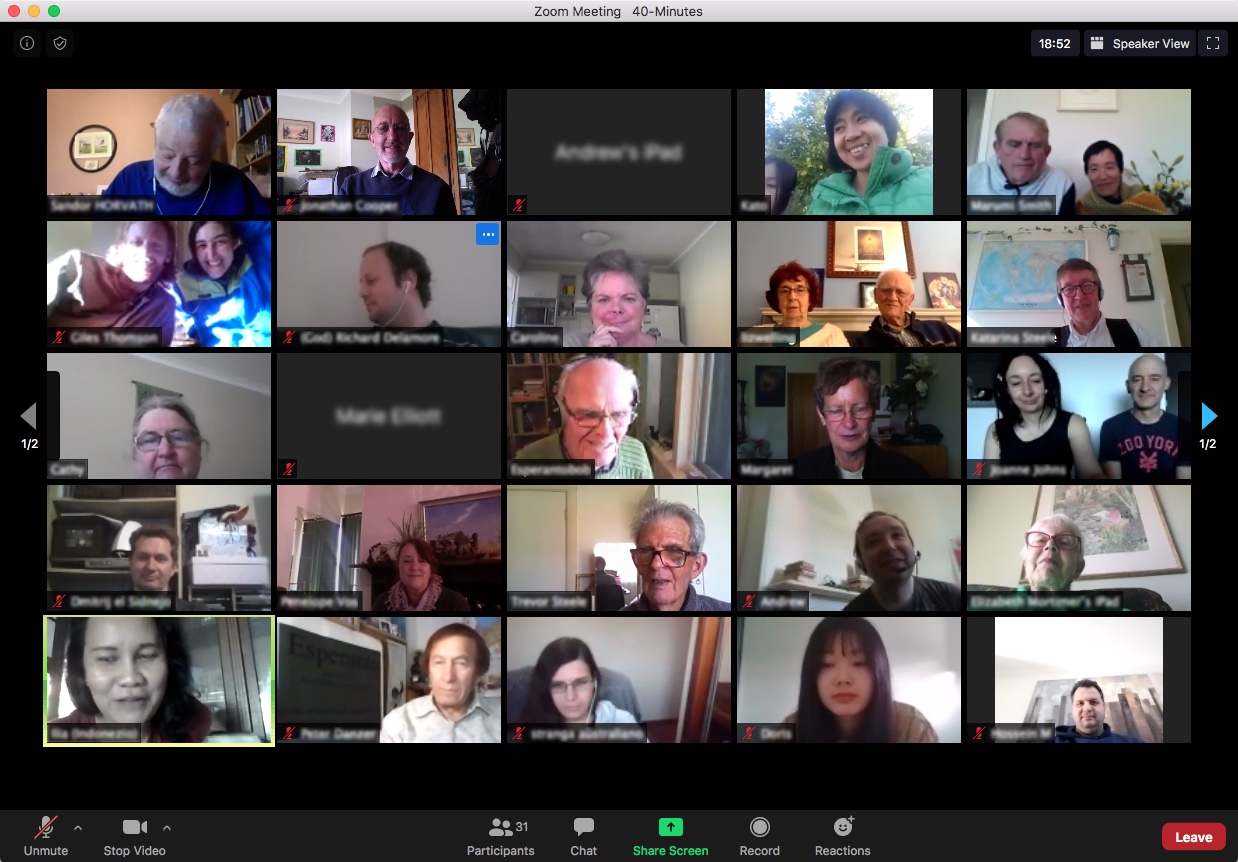
Due to the coronavirus pandemic, and the rules of social distancing, regular meetings of Esperanto clubs have had to stop. Instead, a new form has been set up: the virtual meeting – most often via the video group chat system, Zoom. While the older Skype system works like a telephone conversation (one person calls others, who already must be connected to the caller), Zoom works in a way like a traditional meeting place: Anyone with the link and password is allowed to enter. [1] In addition, Skype is free for conversations with no time limits, and theoretically no limit on the number of participants [2], while a free Zoom account allows meetings only up to 40 minutes. [3] The paid Zoom account removes that limitation and has other options that may be useful.
Before the pandemic, I used the Skype system (without video) for AEA board meetings, and the Zoom system for occasional NSW Esperanto board meetings, when one or two board members for some reason could not travel to Esperanto House. Currently, every Esperanto NSW board meeting takes place with Zoom for everyone.
Of course, a real, physical meeting has advantages over a virtual one: there are no “technical problems”, you can see and hear each other much better, you can more easily talk on the side to one or more others if you want, and, very importantly, people can eat and drink together! However, for me, a virtual meeting has two real benefits:
I live somewhat far from Sydney and Esperanto House. By public transport, the journey for me takes more than two hours in each direction. That’s why I didn’t often attend the Saturday evening meetings, “Public Esperanto Learning”. However, since the start of virtual meetings, I now just have to walk to my study and turn on my computer.
Second, meetings at Esperanto House usually have people who live quite close to Sydney, and from time to time, Esperanto speakers who visit Sydney from other countries or states. However, distance is not a limitation for a virtual meeting. For example, it was a pleasure to meet an Esperanto speaker from Orange (a NSW regional city) in some Zoom meetings in which I participated. In fact, during these meetings, it is not uncommon to have more people from overseas than from Australia.
Are there any other limitations or problems of virtual meetings, apart from those mentioned as advantages of real meetings? Yes:
Because people can come – and in fact do come – anytime, from anywhere in the world, there’s no opportunity to really meet new people. I was sometimes aware that some already knew others I didn’t know – perhaps during a UK or overseas trip. And often, during a two-hour meeting, there were even people who never spoke.
Another problem is that sometimes two or more people start talking at the same time, due to the inevitable time delay.
These two limitations are more or less natural results of the technology. However, another is more evident due to the other limitations: So far most of the ordinary (ie, non-board) meetings I have attended have been unstructured. Sometimes a topic is proposed for discussion, but this is not infrequently ignored, or the discussion/chat wanders off. During one meeting, to celebrate Trevor Steele’s 80th birthday (shown here), everyone had the opportunity to say a few words to Trevor, so there was some structure.
An interesting experiment like this will take place very soon: a virtual one-day Australian “congress”, on Sunday, 7 June 2020, from 8:30am to 8:00pm (NSW time zone). It will feature contributions from leading Esperantists from Australia and the world, including Duncan Charters (president of UEA), Renato Corsetti, jOmO, Katalin Kováts, Keyhan Sayadpour (president of the Iranian Esperanto Association) and our own Trevor Steele. There will also be some language sessions for beginners. You can participate in the whole day or individual sessions and it will be completely free. AEA is paying for a Zoom account that will enable unlimited sessions and other features. (Visit the AEA website for more information. This will be an interesting and useful experiment because, while we hope that the upcoming Australian and New Zealand Congress and Summer Course in Sydney (January 2021) will still take place at Sancta Sophia College, it is possible that people from overseas – and possibly residents of some Australian states – will not be allowed to travel to NSW then. That is why we are preparing to hold a “hybrid” congress: both physical and virtual.
– Jonathan Cooper, treasurer of Esperanto NSW and vice president of AEA
Notes:
1. Zoom also enables the organiser to allow each person in individually.
2. “Theoretically” because, in my experience, if more than a few participate with video, the quality of the connection noticeably degrades.
3. After 40 minutes, the meeting has to be restarted and everyone has to rejoin.
(This article originally appeared in the June 2020 issue of Telopeo.)
